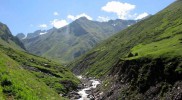
General Geography
General Geography
The Great Himalayan National Park (GHNP) is 754km² in area, with the adjacent Tirthan and Sainj wildlife sanctuaries contributing an additional 61 km² and 90km² of land, respectively. The park’s northern, eastern and southern boundaries are protected by steep ridges and permanent snow. An area of 257km², beginning on the park’s western periphery, has been designated an ecozone, and is populated by GHNP’s original inhabitants.
GHNP’s lowest altitude is 1,700m above sea level, and its highest peak reaches almost 5,800m.
Biogeographically, GHNP is at the junction of the world’s two major faunal realms ‒ the Oriental to the south and Palaearctic to the north. The park’s temperate forest flora and fauna represent the westernmost limit of the Sino-Japanese region, whilst its high-altitude ecosystem has affinities with the adjacent Western and Central Asiatic region.
These biogeographic elements are directly linked to the evolution of the Himalaya. During the continental drift, when the Gondwanaland mass welded with Asia and the Tethys Sea was obliterated from the east, the gigantic fold mountains of the Tertiary Himalaya-Alpine System of Eurasia were formed.
Thus, temperate and alpine ecosystems exist within the geographically compact terrain of the park.






